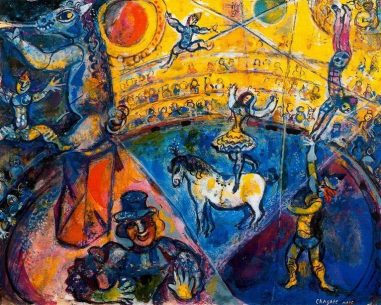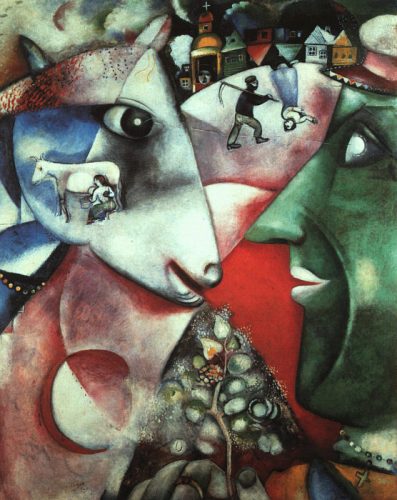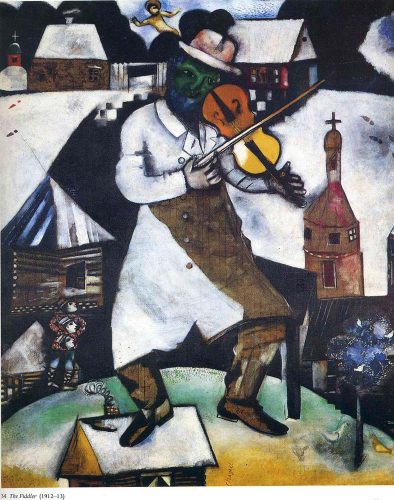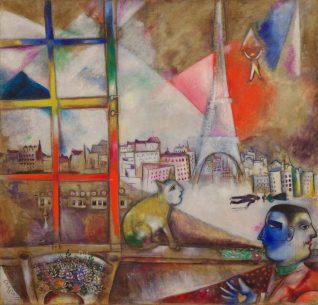 Born on July 7th, 1887 in Vitebsk, Russia, Marc Chagall was a highly versatile artist, known for his work with paint, stained glass, tapestry and ceramics to give just a few examples of his polymath talents.
Born on July 7th, 1887 in Vitebsk, Russia, Marc Chagall was a highly versatile artist, known for his work with paint, stained glass, tapestry and ceramics to give just a few examples of his polymath talents.
Chagall studied at the Imperial Society for the Protection of the Arts between 1907 and 1910 in St Petersburg and then relocated to Paris. There, he forged links with Robert Delaunay and Guillaume Apollinaire, and developed his passion and knowledge for Cubism and Fauvism.
He held his debut solo show at Berlin’s Der Sturm Gallery in 1914, after taking part in 1912’s Salon d’Automne and Salon des Indépendants. Chagall was born and raised in what is now part of Belarus, and although Marc Chagall art began to take form in the eastern Bloc, it found its true form in France.
 Chagall’s most-well known admirers included Pablo Picasso, who said Chagall was one of only a few artists who understood “what colour really is”. The artist was also one of a small number whose artwork was exhibited at the Louvre whilst they were still alive.
Chagall’s most-well known admirers included Pablo Picasso, who said Chagall was one of only a few artists who understood “what colour really is”. The artist was also one of a small number whose artwork was exhibited at the Louvre whilst they were still alive.
He came from a devoutly religious Jewish family and was only able to enter the city of St Petersburg via a temporary passport due to his faith. After he moved to Paris, he produced nostalgic paintings of Vitebsk that were largely centred upon metaphors and symbolism. The most notable Marc Chagall art works include White Crucifixion (1938), La Mariée (1950), Paris Through the Window (1913) and Circus Horse (1964).
‘I and the Village’ was largely seen as the leading Marc Chagall art masterpiece and was produced in 1911. The work features a goat and a green-faced figure staring at one another as well as a glowing tree, a Russian landscape and scenes of upside-down houses. As you may expect, the work was inspired by Chagall’s memories of his hometown, and its blend of nostalgia and dreamlike imagery were regarded as highly-innovative.
In 1914, Chagall married Bella Rosenfield. He returned to Russia in 1914 and was unable to return to Paris for some time due to World War I. Following the 1917 October Revolution, he became the commissar of the Arts for Vitebsk, establishing its Art College.
 He resigned from the Vitebsk Popular Art School in 1920 due to disagreements with the Suprematists, heading to Moscow to create stage designs for the State Jewish Chamber Theater. He briefly moved to Berlin before heading back to Paris in 1923.
He resigned from the Vitebsk Popular Art School in 1920 due to disagreements with the Suprematists, heading to Moscow to create stage designs for the State Jewish Chamber Theater. He briefly moved to Berlin before heading back to Paris in 1923.
He held his first retrospective at Galerie Barbazanges-Hodebert in 1924 and spent much of the thirties travelling, seeing Italy, Poland, Spain, the Netherlands and Palestine. A high-profile retrospective was held at the Kunsthalle Basel in 1933.
He started work on illustrations for the Old Testament in 1931, but these were only published a quarter of a century later. World War II put Chagall and his family in substantial danger, especially when Hitler invaded France. This caused him to flee to the US and remain there for seven years. His worries were compounded by the fact he was an extremely famous artist at the time, whose works were largely influenced by his Jewish upbringing and Jewish culture.
Once Chagall moved to the US, his works were exhibited in New York and Chicago by Henri Matisse, which boosted his profile there significantly. He returned to Paris in 1948, after Bella’s death. Further exhibitions were held in Amsterdam and London as well as Paris, and he produced his first sculptures in 1951 when he visited Israel. He then travelled to Italy and Greece, with many of his excursions in the 1950s and 1960s resulting from commissions. In 1963, he painted the Paris Opera ceiling, with the canvas covering more than 200 square metres.
 Other Marc Chagall art commissions carried out during the 1960s included windows for Jerusalem’s Hadassah University Medical Center synagogue, a new window for New York’s United Nations building, murals for the same city’s Metropolitan Opera House and cathedral windows in Metz.
Other Marc Chagall art commissions carried out during the 1960s included windows for Jerusalem’s Hadassah University Medical Center synagogue, a new window for New York’s United Nations building, murals for the same city’s Metropolitan Opera House and cathedral windows in Metz.
The Musée du Louvre exhibition was held for a decade, between 1967 and 19777, with another retrospective being held in 1985 at the Philadelphia Museum of Art. Chagall died the same year, in Saint-Paul-de-Vence, aged 97. His work Bestiaire et Musique sold for $4,183,615 and set a record as the most expensive piece by a Modern Western artist sold in Asia.
